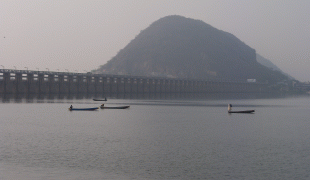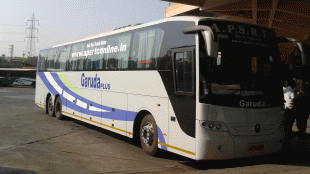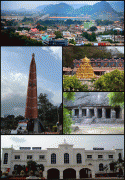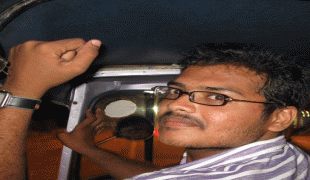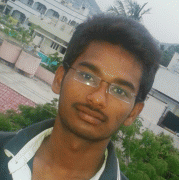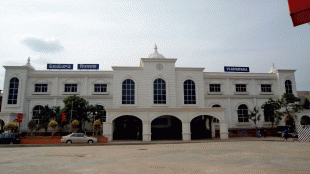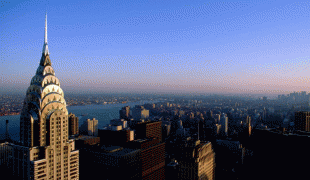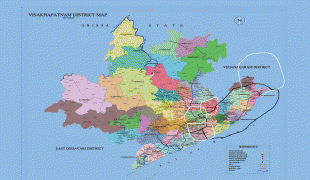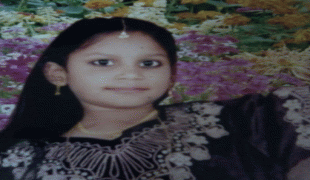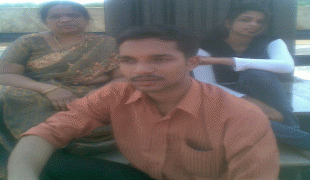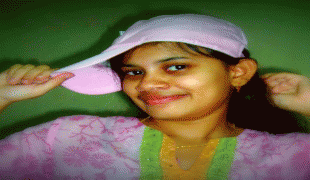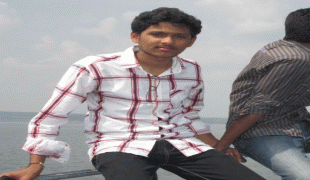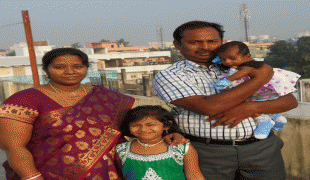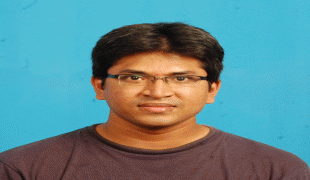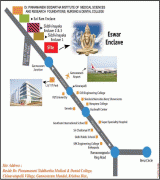Vijayawada
Vijayawada, formerly known as Bezawada, is the second largest city in the Indian state of Andhra Pradesh and is a part of the state's Capital Region. It is the administrative headquarters of the NTR district. Its metropolitan region comprises NTR and parts of Krishna and Guntur districts.Vijayawada lies on the banks of Krishna river surrounded by the hills of Eastern Ghats, known as Indrakeeladri Hills. It geographically lies on the center spot of Andhra Pradesh. The city has been described as the commercial, political, cultural and educational capital of Andhra Pradesh It is the second largest city in Andhra Pradesh with a population of 1,723,000 in 2021, estimated population of 1,991,189 in the Vijayawada Metropolitan Area. It is one of the fastest growing urban areas in India and among the top 10 fastest growing cities in the world according to Oxford Economics report.
Vijayawada is considered to be a sacred place for residing one of the most visited and famous temples of Andhra Pradesh and India, Kanaka Durga Temple of Hindu Goddess Durga residing on the hill named Indrakeeladri. It also serves as the ritual host of Pushkaram (a river worshipping ritual in India) of River Krishna. There is a legend which says that Arjuna, one of the heroes of the Indian epic Mahabharata, prayed on top of the Indrakeeladri Hill in the city and won the blessings of Lord Shiva to get the Pashupatastra to win the Kurukshetra War. It was called Vijayavatika (meaning Land of Victory in Telugu) when Goddess Durga killed the demon Mahishasura and rested on the Indrakeeladri Hill by the River Krishna establishing the victory over evil hence the place got its name Vijayavatika, "Vijaya" meaning victory, and "Vatika" meaning place or land in Telugu. Over the years Vijayavatika name changed to Rajendra Chola Pura during Chola Dynasty and Bezawada during British rule and eventually to Vijayawada.
The city is also the third most densely populated urban built-up areas in the world. and is classified as a Y-grade city by the Sixth Central Pay Commission. The city is the second most populous in the state with a population of more than one million. It was recognised as a "Global City of the Future" by McKinsey Quarterly, which expected an increase to GDP of $17 billion by 2025. In October 2018, it was awarded with ISO 37120 platinum level certification and has been added to the "Global Cities Registry".
Due to the presence of several well-known educational institutions, the city has emerged as a major educational hub in recent times, with many of the nation's students studying in the city. It is predicted to be the world's, and India's, tenth fastest growing city economy through 2035 by an Oxford Economics report. Due to its high ratings in entertainment, construction, food, education, health care, and transport, It is ranked as India's ninth most livable city as per Ease of Living Index 2018, Ministry of Housing and Urban Affairs and the second most livable city in the state of Andhra Pradesh.
The Vijayawada Junction railway station is one of the busiest in the country. It stands as the tenth busiest railway junctions in the country.
There are many legends behind the origin of the name Vijayawada. It is said that Goddess Durga killed Mahishasura and relaxed at this place. As she was victorious, the place came to be known as Vijayawada (vijaya translates to victory and wada as place, literally meaning The Place of Victory). The hill was called as Indrekeeladri since it was frequently visited by Indra and his affiliates. The epic Mahabharata refers to the Indrakiladri hills as the place where Arjuna secured Pashupatastra from Lord Shiva. One of the names of Arjuna is "Vijaya" (invincible). Thus city thereafter came to be known as Vijayavatika ('Vatika' translates to place in Telugu) and later as Vijayawada.
In some legends, Vijayawada was referred to as Rajendracholapura as Virarajendra Chola won a battle against Chalukyas in 1068 and ruled over this place. A tale behind its acquiring the name Bezawada is that Goddess Krishnaveni (River Krishna) requested Arjuna to make a passage for her to merge into the Bay of Bengal. Hence, Arjuna made a bejjam (hole) through the mountains and the place came to be known as Bejjamwada which later changed to Bezawada. Other names of Vijayawada were being Vijayavata, Beejapuram, Kanakaprabha, Kanakapuram, Kanakawada, Jayapuri, Vijayapuri, Phalguna Kshetram and Jananathpura in the twelfth century CE.
Vijayawada is considered to be a sacred place for residing one of the most visited and famous temples of Andhra Pradesh and India, Kanaka Durga Temple of Hindu Goddess Durga residing on the hill named Indrakeeladri. It also serves as the ritual host of Pushkaram (a river worshipping ritual in India) of River Krishna. There is a legend which says that Arjuna, one of the heroes of the Indian epic Mahabharata, prayed on top of the Indrakeeladri Hill in the city and won the blessings of Lord Shiva to get the Pashupatastra to win the Kurukshetra War. It was called Vijayavatika (meaning Land of Victory in Telugu) when Goddess Durga killed the demon Mahishasura and rested on the Indrakeeladri Hill by the River Krishna establishing the victory over evil hence the place got its name Vijayavatika, "Vijaya" meaning victory, and "Vatika" meaning place or land in Telugu. Over the years Vijayavatika name changed to Rajendra Chola Pura during Chola Dynasty and Bezawada during British rule and eventually to Vijayawada.
The city is also the third most densely populated urban built-up areas in the world. and is classified as a Y-grade city by the Sixth Central Pay Commission. The city is the second most populous in the state with a population of more than one million. It was recognised as a "Global City of the Future" by McKinsey Quarterly, which expected an increase to GDP of $17 billion by 2025. In October 2018, it was awarded with ISO 37120 platinum level certification and has been added to the "Global Cities Registry".
Due to the presence of several well-known educational institutions, the city has emerged as a major educational hub in recent times, with many of the nation's students studying in the city. It is predicted to be the world's, and India's, tenth fastest growing city economy through 2035 by an Oxford Economics report. Due to its high ratings in entertainment, construction, food, education, health care, and transport, It is ranked as India's ninth most livable city as per Ease of Living Index 2018, Ministry of Housing and Urban Affairs and the second most livable city in the state of Andhra Pradesh.
The Vijayawada Junction railway station is one of the busiest in the country. It stands as the tenth busiest railway junctions in the country.
There are many legends behind the origin of the name Vijayawada. It is said that Goddess Durga killed Mahishasura and relaxed at this place. As she was victorious, the place came to be known as Vijayawada (vijaya translates to victory and wada as place, literally meaning The Place of Victory). The hill was called as Indrekeeladri since it was frequently visited by Indra and his affiliates. The epic Mahabharata refers to the Indrakiladri hills as the place where Arjuna secured Pashupatastra from Lord Shiva. One of the names of Arjuna is "Vijaya" (invincible). Thus city thereafter came to be known as Vijayavatika ('Vatika' translates to place in Telugu) and later as Vijayawada.
In some legends, Vijayawada was referred to as Rajendracholapura as Virarajendra Chola won a battle against Chalukyas in 1068 and ruled over this place. A tale behind its acquiring the name Bezawada is that Goddess Krishnaveni (River Krishna) requested Arjuna to make a passage for her to merge into the Bay of Bengal. Hence, Arjuna made a bejjam (hole) through the mountains and the place came to be known as Bejjamwada which later changed to Bezawada. Other names of Vijayawada were being Vijayavata, Beejapuram, Kanakaprabha, Kanakapuram, Kanakawada, Jayapuri, Vijayapuri, Phalguna Kshetram and Jananathpura in the twelfth century CE.
Map - Vijayawada
Map
Country - India
 |
 |
| Flag of India | |
Modern humans arrived on the Indian subcontinent from Africa no later than 55,000 years ago. Their long occupation, initially in varying forms of isolation as hunter-gatherers, has made the region highly diverse, second only to Africa in human genetic diversity. Settled life emerged on the subcontinent in the western margins of the Indus river basin 9,000 years ago, evolving gradually into the Indus Valley Civilisation of the third millennium BCE. By, an archaic form of Sanskrit, an Indo-European language, had diffused into India from the northwest. (a) (b) (c), "In Punjab, a dry region with grasslands watered by five rivers (hence ‘panch’ and ‘ab’) draining the western Himalayas, one prehistoric culture left no material remains, but some of its ritual texts were preserved orally over the millennia. The culture is called Aryan, and evidence in its texts indicates that it spread slowly south-east, following the course of the Yamuna and Ganga Rivers. Its elite called itself Arya (pure) and distinguished themselves sharply from others. Aryans led kin groups organized as nomadic horse-herding tribes. Their ritual texts are called Vedas, composed in Sanskrit. Vedic Sanskrit is recorded only in hymns that were part of Vedic rituals to Aryan gods. To be Aryan apparently meant to belong to the elite among pastoral tribes. Texts that record Aryan culture are not precisely datable, but they seem to begin around 1200 BCE with four collections of Vedic hymns (Rg, Sama, Yajur, and Artharva)."
Currency / Language
| ISO | Currency | Symbol | Significant figures |
|---|---|---|---|
| INR | Indian rupee | ₹ | 2 |
| ISO | Language |
|---|---|
| AS | Assamese language |
| BN | Bengali language |
| BH | Bihari languages |
| EN | English language |
| GU | Gujarati language |
| HI | Hindi |
| KN | Kannada language |
| ML | Malayalam language |
| MR | Marathi language |
| OR | Oriya language |
| PA | Panjabi language |
| TA | Tamil language |
| TE | Telugu language |
| UR | Urdu |






